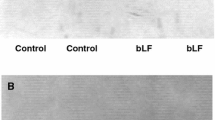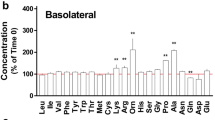Abstract
Epidermal growth factor (EGF) in intestinal lumen regulates many gut epithelial cell functions. Influenced by growth factors at various differentiation stages, enterocytes execute the major task of absorbing nutrient amino acids. The purpose of this study was to investigate the effects of EGF on Na+-independent L-alanine transport in intestinal epithelial cells. Na+-independent [3H]-L-alanine transport was measured in the differentiating Caco-2 cells. In both the undifferentiated and differentiated states, L-alanine uptake occurred via a single saturable Na+-independent system L plus simple passive diffusion. System L activity decreased as the cells progressed from the undifferentiated to the differentiated state. Prolonged incubation with EGF (>30 hours) resulted in a 70% increase in system L activity in both undifferentiated and differentiated cells. EGF stimulated the system L Vmax without affecting Km. System L activity stimulation was inhibited by chelerythrine chloride, cycloheximide, or actinomycin D. These data suggest that intestinal epithelial cell differentiation is associated with a decrease in system L transport capacity. EGF activates system L transport activity through a signaling mechanism involving protein kinase C, independent of cell differentiation state. Both cell differentiation and EGF regulation of system L activity occur via alteration of functional copies of the system L transporter.
Similar content being viewed by others
References
Stevens BR. Amino acid transport in intestine. In Kilberg MS, Haussinger D, eds. Mammalian Amino Acid Transport Mechanisms and Control. New York: Plenum, 1992, pp 149–163.
Hidalgo IJ, Raub TJ, Borchardt RT. Characterization of the human colon carcinoma cell line (Caco-2) as a model system for intestinal epithelial permeability. Gastroenterology 1989;96:736–749.
Mohrmann IM, Mohrmann J, Biber H, Murer H. Sodium-dependent transport of Pi by an established intestinal epithelial cell line (Caco-2). Am J Physiol 1986;250:323–330.
Blais A, Bissonnette P, Berteloot A. Common characteristics for Na+-dependent sugar transport in Caco-2 cells and human fetal colon. J Membrane Biol 1987;99:113–125.
Brandsch M, Miyamoto Y, Ganapathy Y, Leibach FH. Expression and protein kinase C-dependent regulation of peptide/H+ cotransport system in the Caco-2 human colon carcinoma cell line. Biochem J 1994;299:253–260.
Carpenter G, Cohen S. Epidermal growth factor. J Biol Chem 1990;265:7709–7712.
Hernandez-Sotomayor SMT, Carpenter G. Epidermal growth factor receptor: Elements of intracellular communication. J Membrane Biol 1992;128:81–89.
Thompson JF. Specific receptors for epidermal growth factor in rat intestinal microvillus membranes. Am J Physiol 1988;254:429–435.
Britton JR, George-Nascimento C, Udall JN, Koldovsky O. Minimal hydrolysis of epidermal growth factor by gastric fluid of preterm infants. Gut 1989;30:327–332.
Podolsky DK. Healing the epithelium: Solving the problem from two sides. J Gastroenterol 1997;32:122–126.
Pan M, Stevens BR. Differentiation- and protein kinase C-dependent regulation of alanine transport via system B. J Biol Chem 1995;270:3582–3587.
Pan M, Stevens BR. Protein kinase C-dependent regulation of L-arginine transport activity in Caco-2 intestinal cells. Biochim Biophys Acta 1995;1239:27–32.
Pan M, Malandro M, Stevens BR. Regulation of system y+ arginine transport capacity in differentiating human intestinal Caco-2 cells. Am J Physiol 1995;268:578–585.
Christensen HN. Role of amino acid transport and countertransport in nutrition and metabolism. Physiol Rev 1990; 70:43–77.
Wang H, Kavanaugh MP, North RA, Kabat D. Cell-surface receptor for ecotopic murine retroviruses is a basic aminoacid transporter. Nature 1991;352:729–731.
Rajan DP, Huang W, Kekuda R, George RL, Wang J, Conway SJ, Devoe LD, Leibach FH, Prasad PD, Ganapa-thy V. Differential influence of the 4F2 heavy chain and the protein related to b(0,+) amino acid transport on substrate affinity of the heteromeric b(0,+) amino acid transporter. J Biol Chem 2000;275:14331–4335.
Sugawara M, Nakanishi T, Fei YJ, Huang W, Ganapathy ME, Leibach FH, Ganapathy V. Cloning of an amino acid transporter with functional characteristics and tissue expression pattern identical to that of system A. J Biol Chem 2000; 275:16473–16477.
Gu S, Roderick HL, Camacho P, Jiang JX. Identification and characterization of an amino acid transporter expressed differentially in liver. Proc Natl Acad Sci USA 2000;97:3230–3235.
Stevens BR, Ross HJ, Wright EM. Multiple transport pathways for neutral amino acids in rabbit jejunal brush border vesicles. J Membrane Biol 1982;66:213–225.
Van Winkle LJ, Campione AL, Gorman JM. Na+-independent transport of basic and zwitterionic amino acids in mouse blastocysts by a shared system and by processes which distinguish between these substrates. J Biol Chem 1988;263:3150–3163.
Kilberg MS, Handlogten ME, Christensen HN. Characteristics of an amino acid transport system in rat liver for glutamine, asparagine, histidine, and closely related analogs. J Biol Chem 1980;255:4011–4019.
Betran J, Testar X, Zorzano A, Palacin M. A new age for mammalian plasma membrane amino acid transporters. Cell Physiol Biochem 1994;4:217–241.
Margolis B, Rhee SG, Felder S, Mervic M, Lyall R, Levitzki A, Ullrich A, Zilberstein A, Schlessinger J. EGF induces tyrosine phosphorylation of phospholipase C-II: A potential mechanism for EGF receptor signaling. Cell 1989;57:1101–1107.
Ellis C, Moran M, McCormick F, Pawson T. Phosphorylation of GAP and GAP-associated proteins by transforming and mitogenic tyrosine kinases. Nature 1990;343:377–381.
Akiyama T, SaitoT, Ogawara H, Toyoshima K, Yamamoto T. Tumor promoter and epidermal growth factor stimulate phosphorylation of the c-erbB-2 gene product in MKN-7 human adenocarcinoma cells. Mol Cell Biol 1988;8:1019–1026.
Fain JN. Regulation of phosphoinositide-specific phospholipase C. Biochim Biophys Acta 1990;1053:81–88.
Carpenter G, Soler C, Baulida J, Beguinot L, Sorkin A. Interaction of signaling and trafficking proteins with the carboxyterminus of the epidermal growth factor receptor. Ann N YAcad Sci 1995;766:44–51.
Author information
Authors and Affiliations
Rights and permissions
About this article
Cite this article
Pan, M., Souba, W.W., Karinch, A.M. et al. Epidermal growth factor regulation of system L alanine transport in undifferentiated and differentiated intestinal Caco-2 cells. J Gastrointest Surg 6, 410–417 (2002). https://doi.org/10.1016/S1091-255X(02)00004-5
Issue Date:
DOI: https://doi.org/10.1016/S1091-255X(02)00004-5




